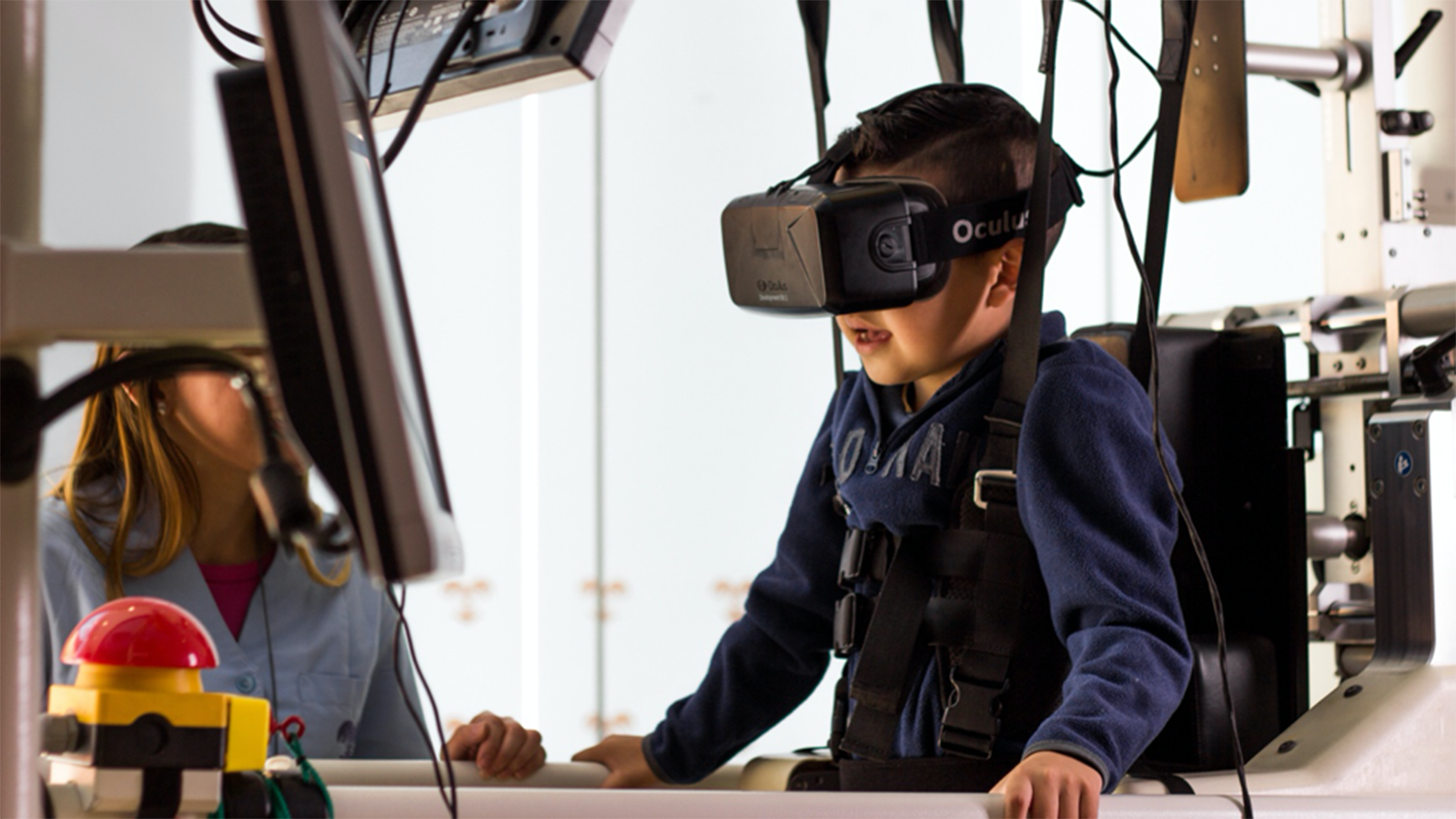
Young patients use virtual reality to focus on healing

Above: Children undergoing rehabilitation for mobility impairments use virtual reality to stay focused and motivated throughout their physical therapy session. The introduction of virtual reality into treatment is part of a project with Arizona State University Lecturer Javier Gonzalez-Sanchez and faculty at the Panamerican University in Guadalajara, Mexico. Photo courtesy of Javier Gonzalez-Sanchez
Physical therapy is an important part of healing and recovery for children experiencing mobility impairments, but it can be distracting, difficult and dull.
Arizona State University Lecturer Javier Gonzalez-Sanchez spent Fall 2019 as a visiting professor at the Panamerican University Guadalajara campus in Mexico. When a former student invited him to collaborate on a project to improve rehabilitation for children, Gonzales-Sanchez was eager to get involved.
Gonzalez-Sanchez’s research is focused on the intersection between software engineering and human-computer interaction — two areas involved in rehabilitative robotics as well as virtual reality technology. Further combining them would make the robot-aided physical therapy experience more effective and more enjoyable.
A busy therapy environment
The children in Mexico receiving therapy use rehabilitation robots in a large, flat space that also houses other instruments. While young patients undergo rehabilitation with the robots, there is plenty of activity going on in the space. Other children, therapists, parents, visitors, machinery and additional factors can make the physical therapy environment detrimental to a child’s rehabilitative progress.
“You can have a kid of around six or seven years old using the robot, but at the same time there can be small kids around crying,” says Gonzalez-Sanchez, who teaches computer science and software engineering in the Ira A. Fulton Schools of Engineering at Arizona State University. “The kid doing rehabilitation gets distracted.”
Often, visitors are touring the facilities and observing the robotic equipment. Children undergoing rehabilitation may also feel uncomfortable being observed.
“When doing rehabilitation in the robot, you should be really focused and you should be making an effort to make it count,” says Gonzalez-Sanchez. “They only have 30 minutes. It’s a small period of time, and if they don’t put in the effort to make progress, it doesn’t work.”
The number of sessions patients undergo varies widely, but depending on their progress they may require a significantly longer treatment.
Other distractions that affect the patient’s progress come not only from people in the area, but also from the machine itself.
The device provides feedback about performance, but that information is for the therapist, says Gonzalez-Sanchez. The data is graphically displayed in view of both the therapist and the patient, but this is distracting for the patients because they try to interpret the meaning behind the plots.
Real problems solved by virtual solutions
The amount of activity surrounding the patient can be detrimental to their efforts to concentrate solely on their rehabilitation.
Enter virtual reality — the technology that can keep kids focused on the surroundings in a way that is productive for their physical therapy. Instead of paying attention to people touring the facility or data on a screen, children can focus on moving their legs in the correct way.
“The university started using virtual reality to put the kid in an environment where they forget that they are there,” says Gonzalez-Sanchez. “There’s no noise, the audio from outside is canceled, and basically you are in a different place.”
With distraction addressed, the team faced the challenge of keeping patients engaged throughout rehabilitation. Once the children got used to the virtual reality environment, the novelty wore off and the experience was repetitive and boring.
“We started thinking about what we can do to keep engagement high,” says Gonzalez-Sanchez. “We wanted to measure the engagement and the emotional factors in the kid, but we didn’t want to ask them because that distracts them from the therapy.”
The team initially considered measuring emotions using facial gesture tracking, skin conductivity and heart rate, but eventually settled on using a headpiece to measure brain activity during rehabilitation.
“We measure the engagement they have during activity, and with the measure of emotion, we can trigger changes in the virtual reality environment,” says Gonzalez-Sanchez.
After testing headpieces to ensure they fit well and were comfortable, the team was able to take measurements without interrupting the patient’s progress. With the data, they altered the virtual reality setting to be more dynamic and more personalized to what the patients need to stay focused during rehabilitation.
In a real environment, therapists typically provide a ball or a toy and encourage the patient to reach for it or move toward it, providing some kind of reward incentive. Similarly, challenges and incentives are provided in the virtual reality environment.
“It’s like a video game, where at some point you change the level. But it’s not about ability, it’s about how you feel,” says Gonzalez-Sanchez. “You start working, you have a goal to move from one point to another, and once you achieve that goal we want to see if you’re still engaged and if you’re enjoying this. Then we move to another level. If you get bored, we introduce some type of new element to the environment.”
Gonzalez-Sanchez, who is back at ASU this semester, plans to further develop the project with the team in Mexico. He and his collaborators, Carolina Del-Valle Soto and Jafet Rodriguez Muñoz from the Panamerican University (Universidad Panamericana), plan to focus on improving the intelligence of the system in terms of different approaches to keep patients engaged throughout sessions.
“The ultimate goal is to deploy the system with children’s rehabilitation centers, particularly the two that have a strong collaboration with the Universidad Panamericana in the cities of Guadalajara and Aguascalientes,” says Gonzalez-Sanchez. “We hope this deployment will be beneficial and other centers could adopt it. As a team, we look forward to continuing to provide solutions that enhance patients’ recovery.”



































